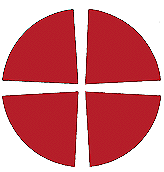 Derby
Methodist
History
Derby
Methodist
History

 Derby
Methodist
History
Derby
Methodist
History

Our story began with Rachael Dobinson who accompanied Sarah Crosby when she moved to Derby in 1761, with the specific intention of introducing Methodism to the town. Mrs Dobinson (1725-1803) was one of the first Methodists in Derby. Originally resident in London, she is said to have come under religious influence after her marriage in 1753. The final stage in the conversion process was achieved after hearing a sermon by the evangelical minister William Romaine in 1758. She subsequently attended class meetings at the Foundery and became a close friend of Sarah Crosby.
Sarah Crosby (1729-1804) was born in Leeds, Yorkshire. She inclined toward Calvinism as a young woman but joined the Methodists after hearing Wesley preach. She moved to London in 1757 after her husband deserted her and was appointed a class leader at the Foundery. Crosby moved to Derby with the Dobinsons and became one of the first female preachers in Methodism. With Wesley's encouragement, she travelled extensively on preaching tours between London and Yorkshire for many years before retiring to her birthplace Leeds.
The flame of Methodism was lit in Derby when John Wesley came to the town in 1762 for the first time to visit the Dobinson Family. He came again in 1764 and opened the new chapel in 1765.
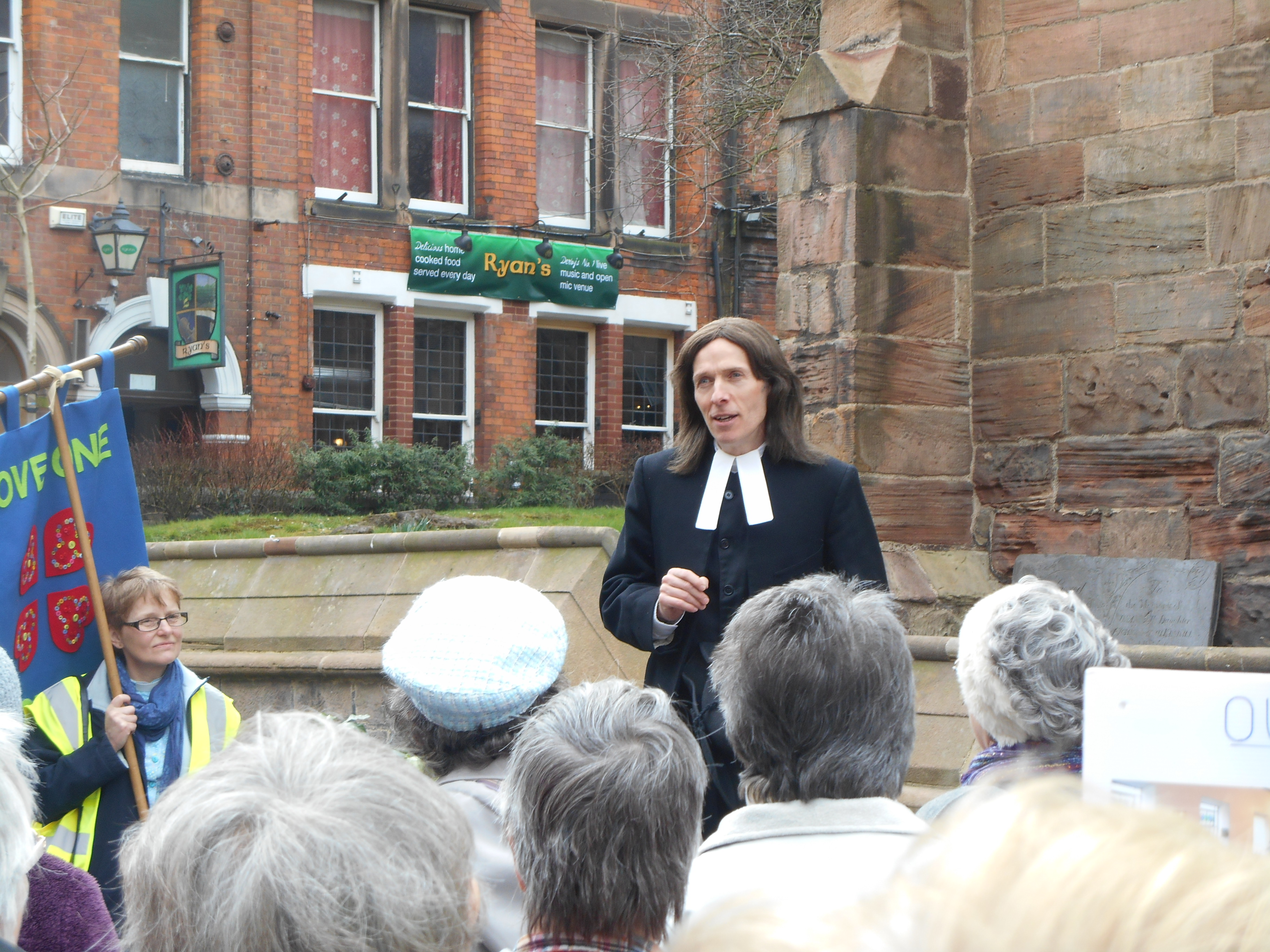 At 2pm Mark Topping performed as John Wesley (1703-1791) to preach again in
Derby by St Peter's Church to a gathering of about 100 Methodists representing
the churches in the Derby Circuit. There were 11 banners present as we
celebrated 250 years of Methodism since the opening of the first chapel in
Derbyshire. The walk commenced at 2:15 and proceeded to visit numerous places
of Methodist interest.
At 2pm Mark Topping performed as John Wesley (1703-1791) to preach again in
Derby by St Peter's Church to a gathering of about 100 Methodists representing
the churches in the Derby Circuit. There were 11 banners present as we
celebrated 250 years of Methodism since the opening of the first chapel in
Derbyshire. The walk commenced at 2:15 and proceeded to visit numerous places
of Methodist interest.
We walked through the Market Place where in 1764 John Wesley was given permission to preach. A multitude of people had gathered before five in the afternoon. As John Wesley began to preach the people lifted their voices and shouts resounded on every side. Stones and pebbles were thrown but no one was hurt.
The walkers then gathered outside the Cathedral near to where John Wesley took refuge in Dobinson's house in Iron Gate. John Wesley recorded in his journals 15 visits to Derby usually enjoying the hospitality offered by the Dobinson family.
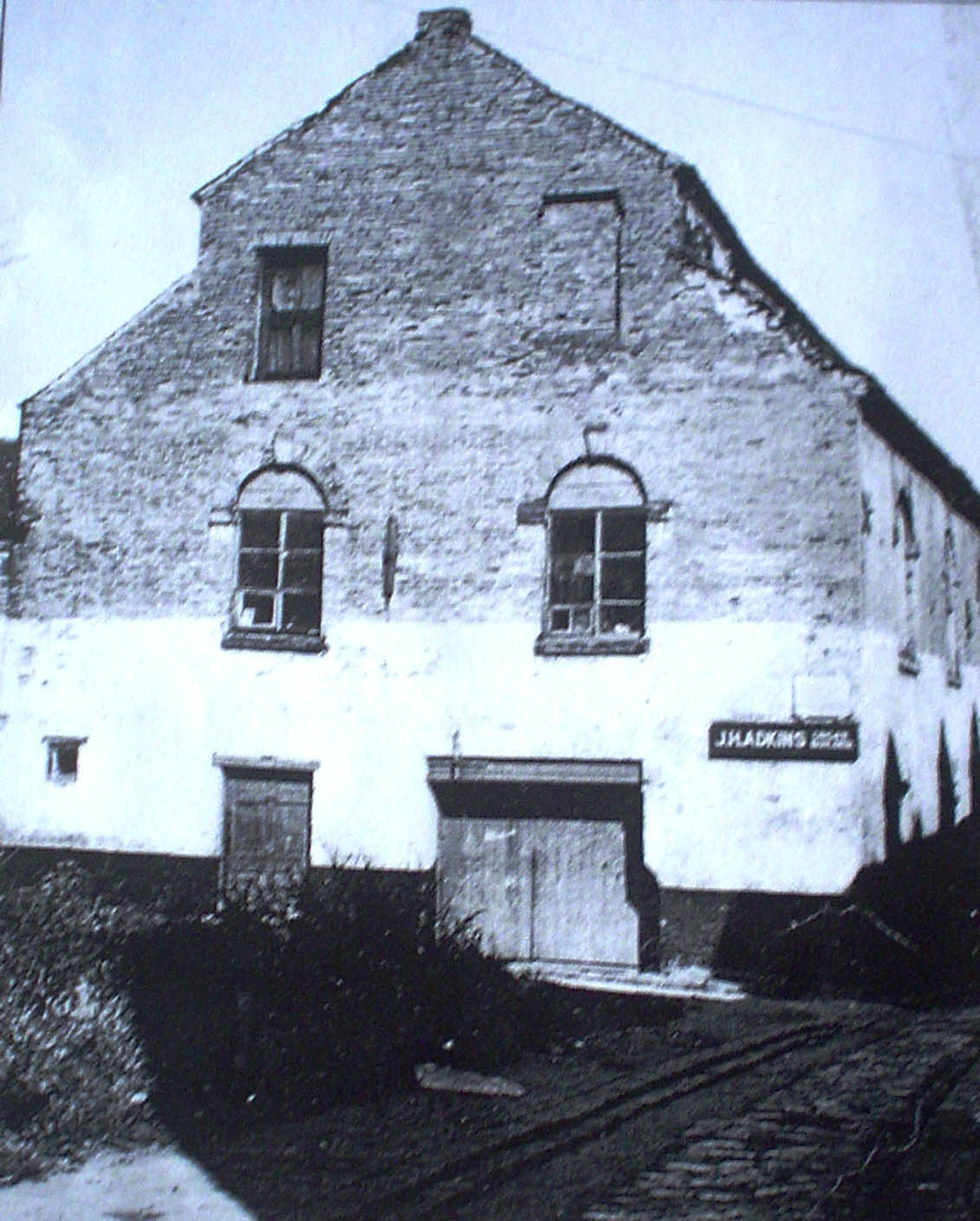 Within three years of John Wesley's first visit a Wesleyan Chapel opened in
St. Michael's Lane, the first chapel in Derbyshire (demolished
January 1973). This was the forerunner of other chapels in and around the town.
John Wesley preached at the chapel on 20th March 1765. There is reference to
this being the official opening of a Methodist Conventicle
(you need a dictionary).
Within three years of John Wesley's first visit a Wesleyan Chapel opened in
St. Michael's Lane, the first chapel in Derbyshire (demolished
January 1973). This was the forerunner of other chapels in and around the town.
John Wesley preached at the chapel on 20th March 1765. There is reference to
this being the official opening of a Methodist Conventicle
(you need a dictionary).
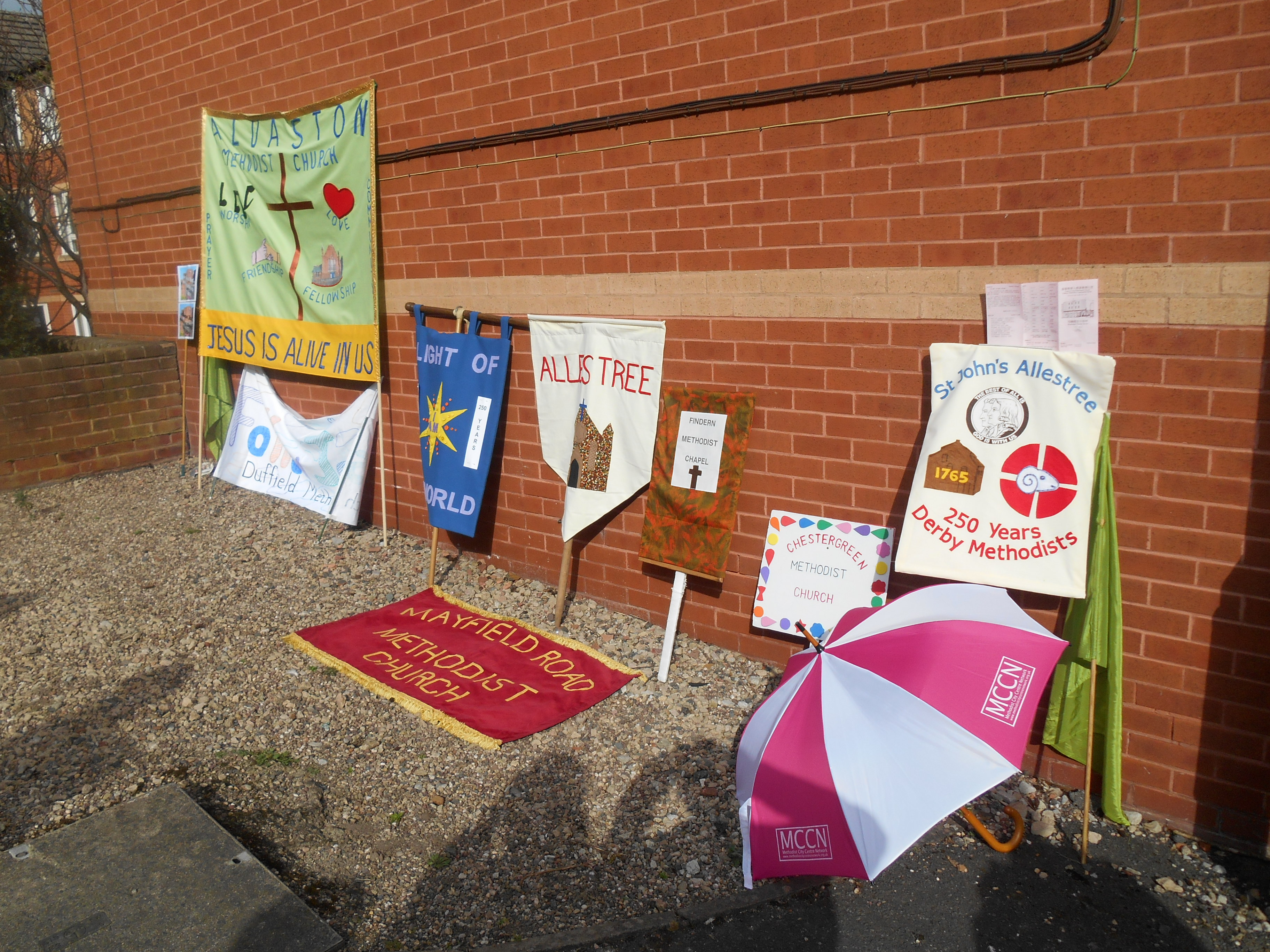 We gathered at the site of the first chapel. The banners were placed against
the wall of the building now on that site and we sang "Love Divine".
It was the custom before the 1939-45 War for a commemorative procession to take
place once a year starting from the Market Place followed by a short service
outside the building. President of Conference unveiled the white marble Tablet
on 16th May 1925.
We gathered at the site of the first chapel. The banners were placed against
the wall of the building now on that site and we sang "Love Divine".
It was the custom before the 1939-45 War for a commemorative procession to take
place once a year starting from the Market Place followed by a short service
outside the building. President of Conference unveiled the white marble Tablet
on 16th May 1925.
In this building
Which was the first Methodist preaching
House in Derbyshire
John Wesley preached
On March 20th 1765
Erected by the Derby & District Wesley Guild Society
1925
Hymns sung at the occasion were -
But the rest is bad news. The building was demolished in 1971. Arthur Spencer wrote to me to say that the tablet had been taken to Green Hill Central Methodist Church for safe keeping but when he arrived there as Superintendent Minister for Derby South he discovered that the tablet was already broken into many small pieces and was disposed of.
Rachael Dobinson served as a class leader and visitor to the sick and dying for the rest of her life. She died on April 12th 1803 after a long period of ill health. In keeping with her background, she was buried at the local parish Church and had a funeral sermon preached at the Methodist chapel.
The walk continued under St Alkmund's way then up to St Mary's to cross over the bridge to the site of St Alkmund's Church. There have been various church buildings on this site since the eighth century. This area was a peaceful oasis with a Georgian Square, wrought iron railings, gas lamps and cobbled streets. Steps went down to cross over Bridge Gate. And the main route through Derby went around the square to pass King Street Chapel that stood where the multi-storey car park now is.
Recent research revealed a letter asking a travelling preacher named Murlin to call in at Mrs Dobinson's house in Bridge Gate. This was in 1883. So It seems either that the information is incorrect or the Dobinson's moved from Iron Gate to Bridge Gate. This would support the idea that she was buried at St Alkmund's.
The walk continued to the site of King Street Chapel on the corner of Chapel Lane, where we stood inside the boundary of the chapel grounds by the two remaining trees. A friend of mine remembered that when he was a boy he saw skulls lined up on the wall as the bones were collected from the grave yard during the demolition of the chapel.
The chapel in St. Michael's Lane was not well placed and did not meet the growing needs of the Methodists. A new Chapel built in King Street, opened in 1805, on this site with seating for 800 people.
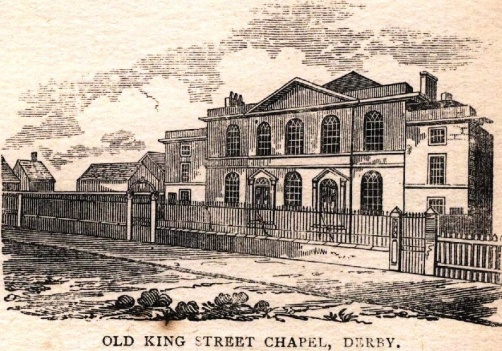
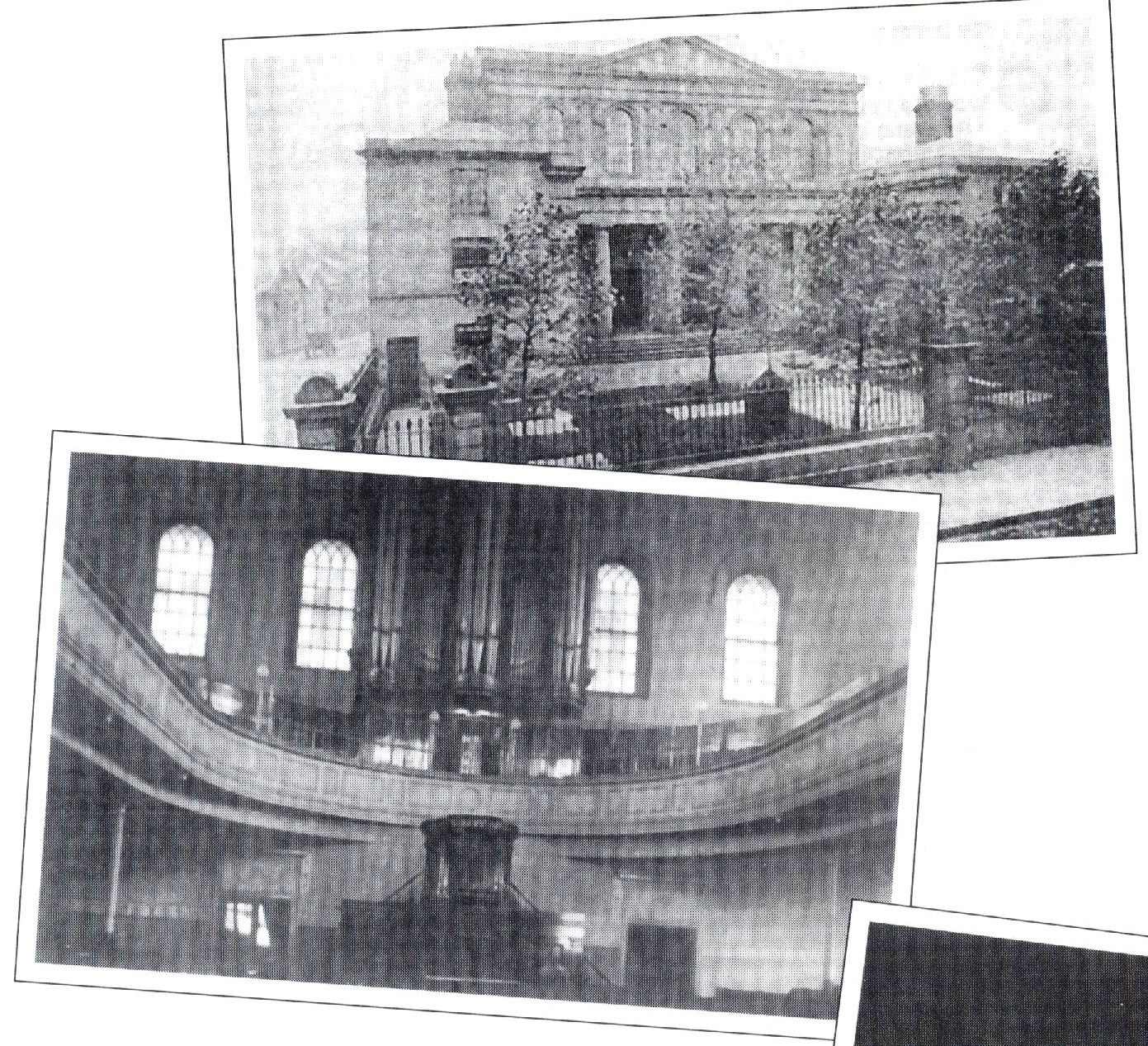
The continued growth of Methodism led to a larger replacement building in classical style, for 1600 people opened in 1841. King Street Chapel was a prominent building in the town and the mother church and head of the first Derby Wesleyan Circuit. Two of the trees planted along the front of the chapel still stand today.
School rooms were built in Chapel Street in 1852. Attendance in 1858 was 150 scholars. The chapel had to close in October 1947 after the roof was declared unsafe. Church services continued in Chapel Street school rooms until March 1961.
King Street Methodist Chapel was struggling with reducing numbers. A housing estate was planned for Allestree that offered an opportunity to start a new church with a catchment area of 10,000 people. The King Street properties were sold. Land was purchased in Allestree and a new Methodist Society was formed. The successor was St. John's Methodist church Allestree opened in November 1964.
In the King Street Chapel was a Great War Memorial, comprised of two windows and a marble tablet, unusual in also naming those that returned safely. The chapel was demolished for St Alkmund's Way. Thirty years later, when work on the Dance Centre began in 1997 the tablet was found hidden in the Chapel Street schoolrooms. The marble pieces were moved to St John's, Allestree for safekeeping until Derby City Council agreed to find a safe site and restore the tablet to public view. The King Street War Memorial Tablet returned to its original site and was rededicated on Armistice Day November 11th 2004.
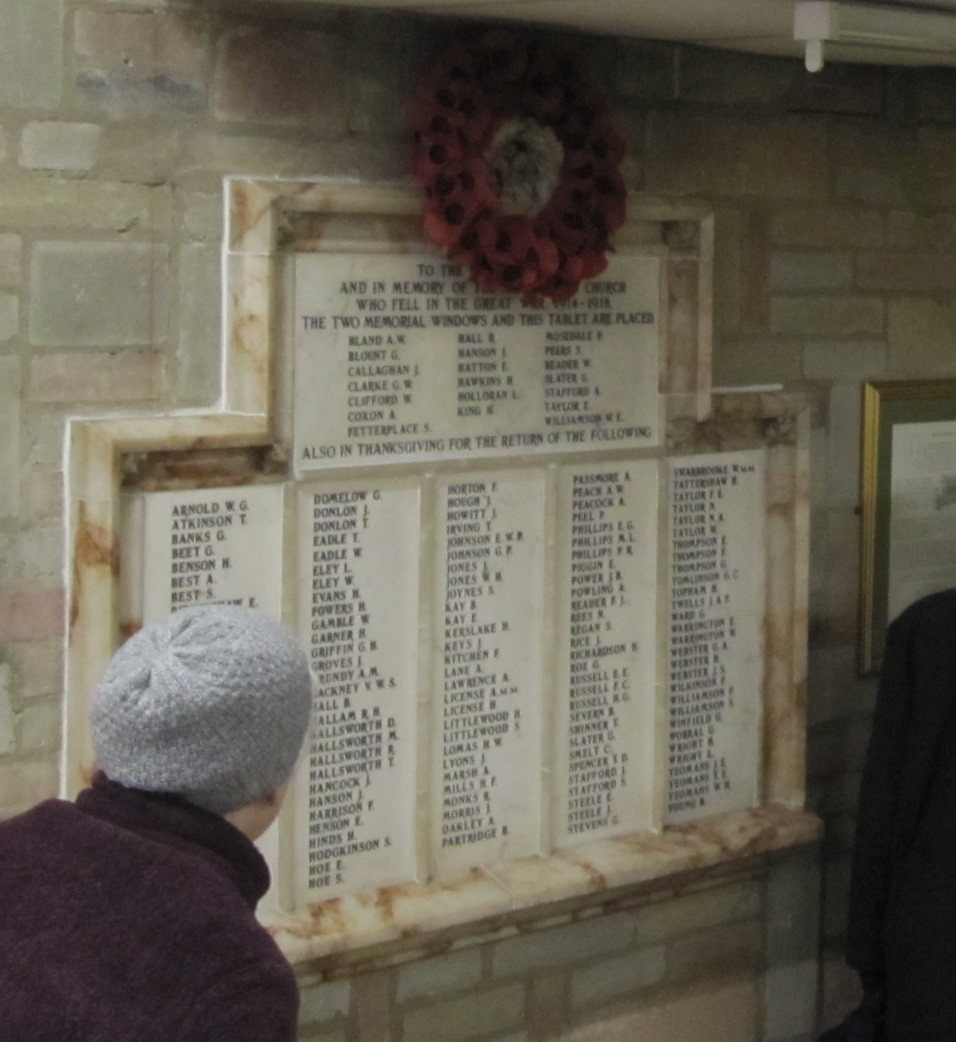 The walkers entered the show rooms to gather around the War Memorial with some
explanation of it. After that the walk continued up Cathedral Road, along
Queen Street into the Cathedral where we all gathered and sang "And can it be" -
a fitting end to a memorable occasion.
The walkers entered the show rooms to gather around the War Memorial with some
explanation of it. After that the walk continued up Cathedral Road, along
Queen Street into the Cathedral where we all gathered and sang "And can it be" -
a fitting end to a memorable occasion.
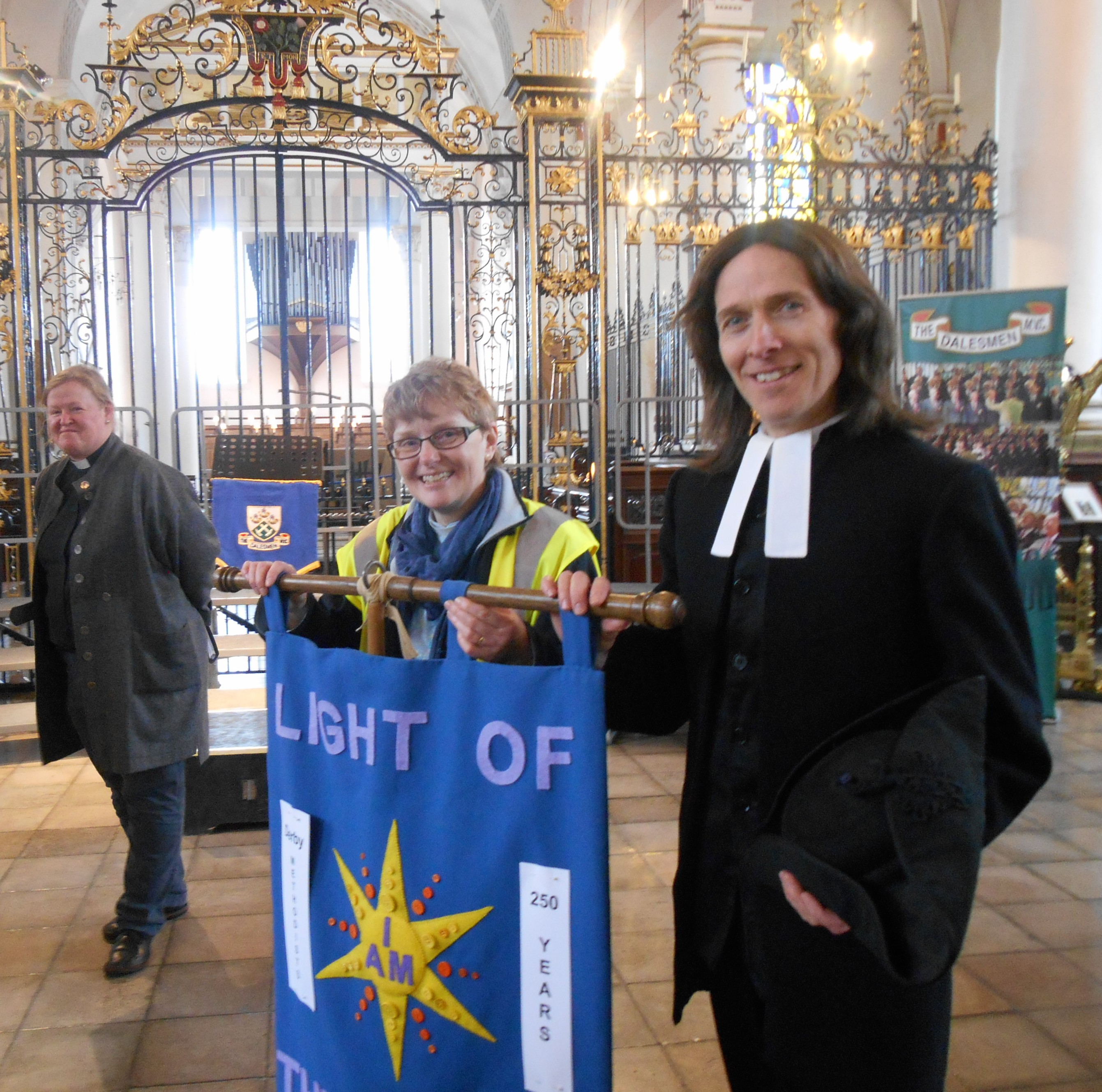 When the first religious census took place in 1851 there were 24 non-conformist
Methodist churches listed in Derby and District. 150 years later after many
closures, amalgamations and new churches the City entered the 21st Century with
three circuits and 24 Methodist churches. Since then the circuits have been
combined into one Derby Methodist Circuit. After 250 years of following John
Wesley we stand where he may have stood when he visited the Dobinson family here
in Iron Gate.
When the first religious census took place in 1851 there were 24 non-conformist
Methodist churches listed in Derby and District. 150 years later after many
closures, amalgamations and new churches the City entered the 21st Century with
three circuits and 24 Methodist churches. Since then the circuits have been
combined into one Derby Methodist Circuit. After 250 years of following John
Wesley we stand where he may have stood when he visited the Dobinson family here
in Iron Gate.
Colin Hinds
Member at St John's Methodist Church